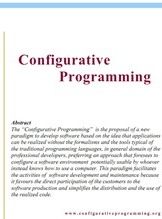Principle of the Orientation of the Configurative Programming
The analysis of the axiomatic model evidences as the base of this new approach to the programming derives having moved the focus
of the programmer from a writing process to a configuration process; if such focus movement effectively simplifies the activity
of software development or instead it makes it more complex depends on how much it succeeded to simplify the configuration process.
It is obvious that a extremely articulate configuration process, based on many elements everyone configurable in extremely meticulous
way, will hardly conduct to the definition of a simple programming language, therefore it won't allow the diffusion of it on a vast
community of programmers.
As the demand to simplify the mechanisms of software development is connected with the demand to simplify the mechanisms to configure
it is necessary to define some configuration levels that can are easily understandable and usable by different categories of users.
This demand makes us affirm that the configurative programming can be considered as oriented to individual and therefore
based on an approach more subjective that objective.
This consideration makes the assignment to define a specific configurative language extremely tiresome, simply because various individuals
have a different idea of the “simplicity” concept.
Therefore we can assert that the implementation of the configurative programming paradigm can take place in different forms: each directed
toward different categories of users. In this sense we can define that the configurative programming constitutes
an “Individual Oriented Programming.”
In order to define a language dedicated to a specific application domain it is sufficient to define a dedicate configurative programming
language that is in a position to satisfy the requirements of a generic individual: an ideal representative of this category of users.
It is obvious that the success of a such configurative language primarily will depend on the correct definition of this ideal individual,
particularly having clear in mind its demands and operational ability, secondarily, having defined configuration mechanisms that a such
individual will consider effectively simple.


